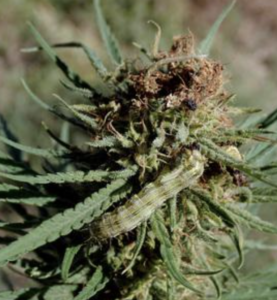 Caterpillars can indeed pose a threat to hemp plants, potentially leading to bud rot and other issues. Here are some strategies you can consider to prevent caterpillar infestations and the resulting bud rot on your hemp plants:
Caterpillars can indeed pose a threat to hemp plants, potentially leading to bud rot and other issues. Here are some strategies you can consider to prevent caterpillar infestations and the resulting bud rot on your hemp plants:
- Physical Barriers: Use physical barriers like floating row covers or mesh nets to prevent adult moths from laying their eggs on the plants. This can effectively reduce the number of caterpillars that hatch and feed on your hemp.
- Regular Inspections: Regularly inspect your hemp plants for signs of caterpillar presence, such as chewed leaves, droppings, or caterpillars themselves. Early detection can help you address the issue before it becomes widespread.
- Handpicking: If you notice caterpillars on your plants, you can manually pick them off and remove them. This method is effective for small-scale cultivation but might be challenging for larger hemp fields.
- Biological Control: Introduce natural predators of caterpillars, such as certain species of parasitic wasps or predatory insects like ladybugs, to help keep caterpillar populations in check.
- Bacillus thuringiensis (Bt): Bt is a naturally occurring bacteria that is toxic to many caterpillar species but is safe for humans, animals, and beneficial insects. It’s available in various formulations and can be applied to the plants. Caterpillars that consume Bt-treated foliage will be affected.
- Neem Oil: Neem oil is a plant-based insecticide that disrupts the growth and development of caterpillars. It’s considered relatively safe for humans, pets, and beneficial insects when used as directed.
- Insecticidal Soaps: These soaps can be effective in controlling caterpillar populations. They work by suffocating and dehydrating the insects. However, be cautious with their use as excessive application might harm beneficial insects and other non-target organisms.
- Cultural Practices: Keep your hemp growing area clean and remove debris, weeds, and plant remnants that might harbor caterpillar eggs or larvae. Proper spacing between plants can also reduce the risk of caterpillar infestations.
- Companion Planting: Some plants, like marigolds and dill, are known to repel certain pests. Consider interplanting these companion plants with your hemp to deter caterpillars.
- Rotate Crops: If possible, rotate your hemp crops with other non-host crops. This can disrupt the life cycle of pests and prevent them from building up in the soil.
- Organic and Chemical Pesticides: If the infestation is severe and other methods haven’t worked, you might consider using approved organic or chemical pesticides. Always follow the recommended dosage and application instructions, and be mindful of the potential impact on beneficial insects and the environment.
Remember that a combination of approaches is often the most effective strategy. Monitor your plants regularly, act promptly when you notice caterpillars, and adapt your pest management plan based on the specific conditions of your hemp cultivation.


Recent Comments